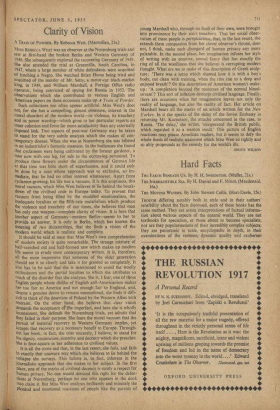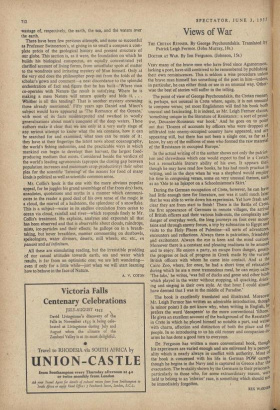THE EARTH BENEATH US. By H. H. Swinnerton. (Muller, 21s.)
THE INEXHAUSTIBLE SBA. By H. Daniel and F. Minot. (Macdonald, 16s.) THE MOVING WATERS. By John Stewart Collis. (Hart-Davis, 15s.) THOUGH differing notably both in , style and in their authors' sensibility about the facts discussed, each of these books has the same method. They are astute interpretations of factual informa- tion about various aspects of the natural world. They are not textbooks for specialists, or those about to become specialists; nor are they popularisations of their incredibly complex subjects; they are panoramic in scale, encyclopxdic in depth, in their examinations of the vastness, dynamic quality and exuberant wastage of, respectively, the earth, the sea, and the waters over the earth.
There have been few previous attempts, and none so successful as Professor Swinnerton's, at giving in so small a compass a com- plete precis of the geological history and present structure of our globe. This section is, as it were, the foundation on which he builds his biological conspectus, an equally concentrated yet clarified account of living forms, from unicellular spots of matter to the wondrous and irritating mystery of Man himself. Only at the very end does the philosopher peep out from the folds of the scholar's 'gown and comment—a neat discordance to the splendid orchestration of fact and figure that he has built—'Where man co-operates with Nature the result is satisfying. Where he is making a mess Nature will return quietly and hide it. . . . Whither is all this tending? That is another mystery crowning those already mentioned.' Fifty years ago Daniel and Minot's subject would have appeared as 'The Romance of the Oceans,' with most of its facts misinterpreted and swathed in woolly generalisations about man's conquest of the deep waters. These authors make' it clear that we are only at a very early stage of any serious attempt to know what the sea contains, how it can be searched for and examined, what uses can be made of it: they have at their fingertips the latest news about oceanography, the world's fishing industries, and the practicable ways in which mankind can begin to develop; then harvest, the largest food- producing medium that exists. Considered beside the verdicts of the world's leading agronomists (apropos the closing gap between population increases and maximum crop-productivity) their sober plea for the scientific 'farming' of the oceans for food of many kinds is political as well as scientific common sense.
Mr. Collis's kook is the one with the more obvious popular appeal, for he juggles his grand assemblage of (far from dry) facts, anecdotes, quotations and myths in a manner which communi- cates to the reader a good deal of his own sense of the magic in a cloud, the marvel of a hailstorm, the splendour of a snowflake. This is a subject—water in its endless circulation from ocean to ocean via cloud, rainfall and river—which responds finely to Mr. Collis's treatment. He explains, analyses and expounds all that has been observed and that is observable about clouds, raindrops, mists, ice-particles and their effects; he gallops on in a breath- taking, but never breathless, manner commenting on dustbowls, speleologists, water diviners, deserts, mill wheels, etc. etc., en passant and ad infinitum.
All these are stimulating reading, but the irresistible prodding of our casual attitudes towards earth, sea and water which results, is far from an optimistic one; we are left wondering— even if only for a little while—just when we will start learning how to behave in the face of Nature.
A. V. COTON



































 Previous page
Previous page